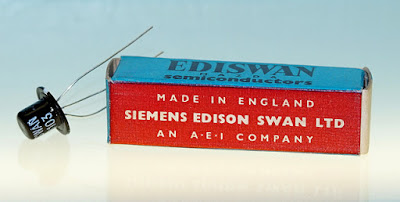Ediswan Semiconductors

Vintage Ediswan Mazda XB103 Germanium Transistor EDISWAN Germanium transistor originally from the late 1950s. The gain on this device is at the very top end of the gain spec @ 105. Edison and Swan merged in Britain in the late 1800s when Swan already held the dominant patents for the incadescent bulb. Ediswan were one of the original companies in the Associated Electrical Industries (AEI) merger from 1929 which included British Thomson Houston. Thomson Houston in the US became General Electric. Many British lamp companies moved into valves (tubes). Indeed the inventor of the first thermionic valve, Ambrose Fleming, worked at Edison Swan's factory at Ponders End in North London. Siemens Brothers (the other brothers) merged with Edison Swan in the early 1950s. It's not clear where Ediswan semiconductors were manufactured but may have been at Woolwich or Ponders End. Siemens Edison Swan had a research lab in West Road, Harlow in the late 1950s doing semiconductor res...


